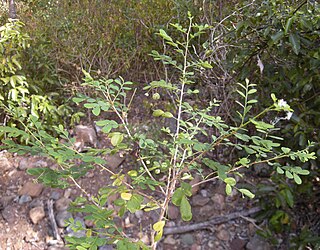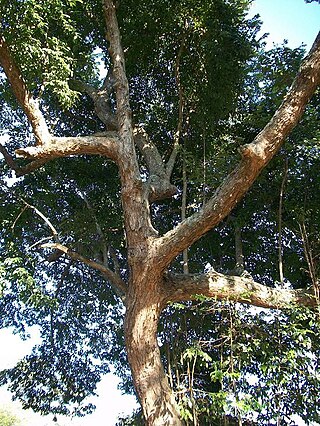Villanova is a name of Latin origin, meaning new town. It is equivalent to Italian Villanuova, French Villeneuve, Spanish Villanueva, and Catalan, Galician, Occitan and Portuguese Vilanova. It may refer to:

Phyllanthus is the largest genus in the plant family Phyllanthaceae. Estimates of the number of species in this genus vary widely, from 750 to 1200. Phyllanthus has a remarkable diversity of growth forms including annual and perennial herbs, shrubs, climbers, floating aquatics, and pachycaulous succulents. Some have flattened leaflike stems called cladodes. It has a wide variety of floral morphologies and chromosome numbers and has one of the widest range of pollen types of any seed plant genus.

Phyllanthaceae is a family of flowering plants in the eudicot order Malpighiales. It is most closely related to the family Picrodendraceae.

The genus Sauropus, of the family Phyllanthaceae, comprises about 40 species of herbs, shrubs or subshrubs, sometimes with woody bases. These plants can be monoecious or dioecious. They are distributed in Southeast Asia, Malesia and Australia.

The family Pandaceae consists of three genera that were formerly recognized in the Euphorbiaceae. Those are:

Leptopus, the maidenbushes, are a genus of plants in the family Phyllanthaceae native to southern Asia from the Caucasus east to China and Maluku. The plants are monoecious herbs and shrubs with simple, entire leaves and small, green flowers.

Bischofia is a genus of plants in the family Phyllanthaceae first described as a genus in 1827. It is native to southern China, the Indian Subcontinent, Queensland, New Guinea, and various islands of the Pacific. It is the only member of the tribe Bischofieae. They are dioecious, with male and female flowers on separate plants, but may rarely be monoecious.
Leptonema is a genus of flowering plant belonging to the family Phyllanthaceae first described in 1824. The entire genus is endemic to Madagascar. It is dioecious, with male and female flowers on separate plants.
- Leptonema glabrum(Leandri) Leandri
- Leptonema venosum(Poir.) A.Juss.

Baccaurea is a genus of flowering plant belonging to the family Phyllanthaceae. The genus comprises over 100 species, distributed from Malesia to the West Pacific. It is dioecious, with male and female flowers on separate plants. Many species contain edible fruits.

Uapaca is a genus of plant, in the family Phyllanthaceae first described as a genus in 1858. It is the only genus comprised in the tribe Uapaceae. The genus is native to Africa and Madagascar. Uapaca is dioecious, with male and female flowers on separate plants.
Andrachne is a genus of flowering plants in the family Phyllanthaceae described by Linnaeus in 1753. It is one of eight genera in the tribe Poranthereae.

Glochidion is a genus of flowering plants, of the family Phyllanthaceae, known as cheese trees or buttonwood in Australia, and leafflower trees in the scientific literature. It comprises about 300 species, distributed from Madagascar to the Pacific Islands. Glochidion species are used as food plants by the larvae of some Lepidoptera species including Aenetus eximia and Endoclita damor. The Nicobarese people have attested to the medicinal properties found in G. calocarpum, saying that its bark and seed are most effective in curing abdominal disorders associated with amoebiasis.

Margaritaria is a plant genus of the family Phyllanthaceae first published as a genus in 1782. It is the smallest pantropical genus of the Phyllanthaceae and, formerly, of the Euphorbiaceae, widely distributed in tropical and subtropical regions of Asia, Africa, Australia, North and South America, and various oceanic islands.
Chorisandrachne is a genus of plants in the family Phyllanthaceae first described as a genus in 1969. It contains only one known species, Chorisandrachne diplosperma, native to southern Thailand.
Meineckia is a genus of flowering plants in the family Phyllanthaceae first described as a genus in 1858.

Lachnostylis is a genus of the family Phyllanthaceae first described as a genus in 1846. It is native to the Eastern Cape and the Western Cape Provinces of South Africa. It is often included in Savia. It is dioecious, with male and female flowers on separate plants.
- Lachnostylis bilocularisR.A.Dyer
- Lachnostylis hirta(L.f.) Müll.Arg.

Gaetano Savi was an Italian naturalist., botanist and mycologist.
Pseudophyllanthus is a monotypic genus of flowering plants in the family Phyllanthaceae. It is one of the eight genera in the tribe Poranthereae. Its closest relative is Poranthera. Its sole species is Pseudophyllanthus ovalis.

Epicephala is a genus of moths in the family Gracillariidae.

Phyllanthus fluitans, also known as the red root floater, floating spurge, or apple duckweed is a species of free floating aquatic plant and herbaceous perennial in the family Phyllanthaceae. This species is one of the only three non-terrestrial species in the genus Phyllanthus, with the other species being P. leonardianus and P. felicis. The generic name comes from Ancient Greek meaning leaf or a leaf flower, and the specific name comes from Latin meaning floating or float. It was described in March 1863 by George Bentham and Johannes Müller Argoviensis.













